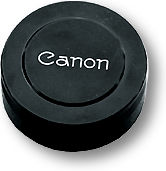With their extremely wide angles of view, wide-angle and super wide-angle lenses gather momentum in their popularity. These lenses accentuate nearby objects by enlarging them and de-emphasize those that are far away by making them smaller.
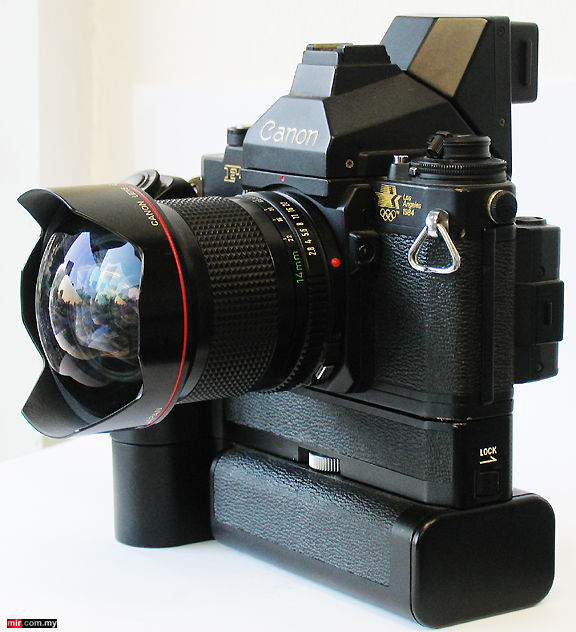 |
The objects therefore seem much farther apart than they really are, creating an elongated perspective. Because of this perspective, even a slight difference in shooting angle or position will cause a great difference in how the subject appears. |
Aberrations at close focusing distances are improved by a floating system; where certain elements move relative to other elements during focusing. A gelatin filter holder in back of the lens accommodates common types of gelatin filters.
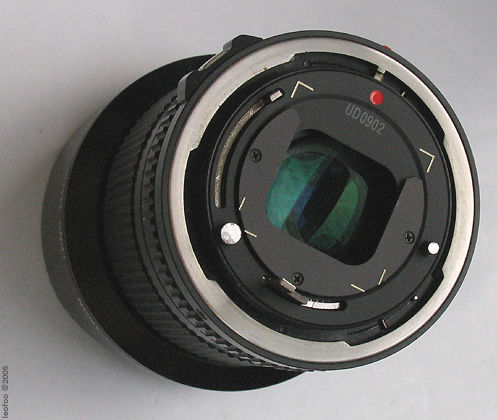 |
Canon once claimed the 14mm lens "..a super wide-angle 14mm lens has the world's shortest focal length excluding fisheye lenses.." which is not particularly true, Nikon has a wider superwide than this 14mm in the Nikkor 13mm f/5.6 ultrawide. |
<<<<---- A view at the back of the lens. Credit: Philip Chong for lending his F1n and 14mm f2.8 L to me for preparing some images used in this site.
However, the 14mm featured here has an distinct advantage over the Nikkor because it boasts a large maximum aperture of f/2.8 as compared with the Nikkor's aperture of f5.6. Apparently, the Nikkor is a special order item whereas the FD 14mm lens is a common regular production item - not to mention the ridiculous price tag it comes with.
The distinguishing features of
super wide-angle lenses in general are their wide angle of view and their extended
perspective. The 14mm is the most extreme example of these characteristics. The diagonal
angle of view covered by the 14mm lens is 114°. To give you a feeling for just
how much this lens takes in, it is more than double the 46° coverage of a 50mm
lens and a little less than double the 35mm's coverage of 63°. Unlike fisheye
lenses, the straight lines of the subject do not become curved as they do with fisheyes,
the distance between close and distant objects is exaggerated by dramatically reducing
the size of the objects in the background. Thus a tremendous feeling of depth is
created. This exaggerated perspective is also influenced by camera angle. For example,
the same room would look quite different if taken from the corner than it would if
taken straight on.
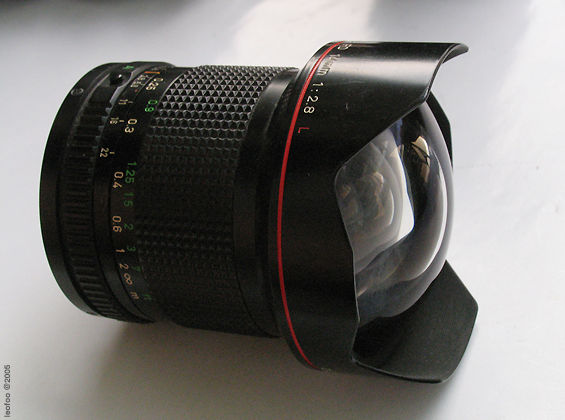 |
It's not easy to master the 14mm lens but once you have familiarized yourself with its optical characteristics, that's where the excitement begins. Even those who are familiar with other wide-angle lenses may find this lens difficult at first. The photographer must have in mind some creative ideas on how to exploit the extreme wide angle of view and the exaggerated perspective. After that, experience is the best guide. |
Generally, optical lens' aberrations and distortions become more severe with shorter focal lengths, so with the extremely short 14mm lens, correcting these problems is especially important. Thus, to overcome such drawbacks and discrepancies, an aspherical element has been employed which has greatly minimized such aberrations and distortion and resulting in an extremely high optical performance.
 |
Another optical characteristic of super wide-angle lenses is their great depth of field. When using short focal length lenses with the focusing ring set to infinity, virtually everything in the picture is in sharp focus. Consequently, super wide-angle lenses are not very useful for isolating your subject using an out of focus foreground and background. |
They are better for producing panoramic, clearly focused compositions. For example, if you choose a small aperture and focus the lens at 25cm (the closest focusing distance for this 14mm lens), everything from about 10cm in front of the lens to infinity will be in relatively sharp focus. This results in some interesting effects in scenery shots where the objective is to emphasize distance.
Tips: Close ups shots can also be interesting with its immense depth of field and close focusing ability.
# When using the lens at close focusing distances, the edge of the image may be distorted depending on the angle at which the camera is held. This makes straight lines running diagonally stand out. Pointing the camera down at a sharp angle, or even shooting straight down on the subject will result in an unusual point of view. This edge distortion should not be confused with the intentionally introduced distortion used in making fisheye lenses. A commonly-held belief is that pictures taken with wide-angle lenses are always distorted, but it is merely that the perspective of a super wide-angle lens is not what the human eye usually sees. When pointed straight at the subject, the lens will produce an undistorted image.
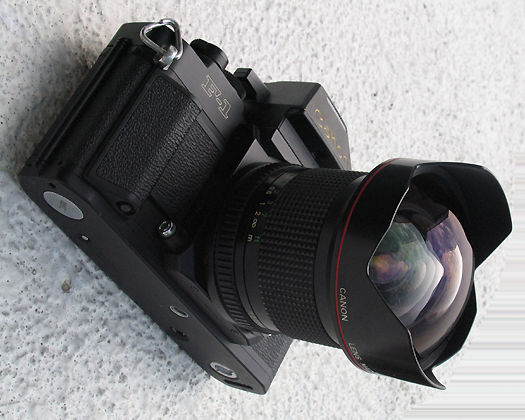 |
# When framing a shot, the photographer's attention is generally occupied by the main subject, and the surrounding areas tend to be overlooked. When the finished picture comes back, it is often not what the photographer had expected. It is important, therefore, to check the entire field of view before taking the picture to make sure that there are no unwanted objects intruding at the corners or distortions around the edges. |
# Since the lens has such a great depth of
field and everything will be in focus, the scene can be checked with the unaided
eye to make sure it is clear of obstructions. Once you understand how the perspective
and resulting differences in image size affect the apparent deformation of the subject,
you will be able to use this lens to produce some extraordinary photographs.
# Keep composition as simple
and straight forward. When you are working in broad daylight and under contrast situations,
remember to compensate for exposure. A view with big portion of the sky, for instance
might affect your exposure reading.
# Although there is no clear
rules of how to use this lens - unless you know or the 'subject knows what you are
shooting , always avoid using this lens on beautiful 'creatures'... nobody likes
'distorted images..
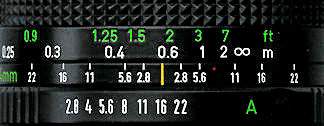 |
The floating element design used enables focusing at close distance to be more precise and less emphasis is given at distance from 1 meter and above due to its immense depth of field of this focal length generates. Also note the depth of field scales marked on the aperture ring is excessively broad at two sides from the focusing and aperture index. |
Some key advantages presented with this lens are:
- With the 14mm's bright f2.8 aperture, low light or indoor handheld photography can be made possible.
- At an angle so the perspective is maintained rectilinear , straight lines are not distorted.
- From a low angle, the perspective will be extremely exaggerated.
- Taking a picture using the camera horizontally does not distort the subject at all.
Disadvantages with this lens are: Almost none. Other
than prices as used units are still too stiff and you need to pay more attention
in handling since the external lens element protruding from the front and most of
all, familiarized with the optical characteristic before use on any important assignments.
* Illustration
on its various applications are welcomed. If chosen to be presented in this section,
appropriate credit will be given.
Sorry, since this
is a non-commercial site - I can't
afford to pay anyone
- as the PIM site is a non profitable site.
 |
New FD 14 mm f/2.8 Lens |
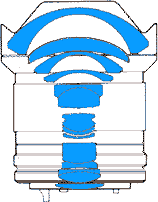 |
Specification: |
Cap: Exclusive (Provided- CA2-3345)
Functions: Auto aperture, full aperture metering (AE operation when used with all Canon AE SLR cameras.
Filter size: Acetate or Gelatin, Built-in Filter Holder
Hood: Built-in
Length x max. diameter: 88.5 mm x 74 mm
Weight: 500g
 |
Older Version: Canon FD 17mm f/4 S.S.C. |
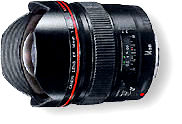 |
Canon stated "...Although based on the original FD 14mm f/2.8 L, this EF version's optical quality has been improved over the manual focus version". This lens employs a large-diameter ground and polished aspherical glass element in the first lens group to thoroughly correct distortion. Also uses a rear focusing system that is designed to correct astigmatism at close focusing distances and improved autofocusing speed. A built-in notched hood for protection with the front lens surface. |
A gelatin filter holder is provided in the rear section of the lens. The Ultrasonic focusing Motor also allows manual focusing at any time without switching the focus mode. Quick data for reference: Focal length and maximum aperture: 14mm f/2.8; Lens construction: 13 elements in 10 groups; Angle of view: 114°; Focus adjustment: Rear focusing system with USM; Closest focusing distance: 0.25 m; Filter size: Rear drop-in gelatin filter holder; Length x max. diameter, weight: 89mm x 77 mm, 560 g
|
Canon EOS SLRs | Canon EF lens Resources
| Back |
Main
Index
Page
of Canon FD lenses
| Back |
Main
Index Page of Canon A & T Series SLR Models
| Message Board | for your Canon A-Series SLR camera(s)
| Message Board | for your Canon T-Series SLR camera(s)
| Message Board | for your Canon T90 SLR camera
| Message Board | for your Canon F-1(n) SLR camera
| Message Board | for your New Canon F-1 SLR camera
| Message Board | for your Canon Optics
in a shared environment
| Message Board | Specifically for Dispose or Looking for Canon Photographic
Equipment
about this
Site
![]()
Home - Photography
in Malaysia
Copyright
© 2000.
leofoo ®. MIR
Web
Development
Team.
Site
Maintenance Editors: Kaipin, Terry Carraway, Gerry, Winston,
Tom & IRwin (Dr Strangelove); Credit: Richard Yeow, general manager
of Canon Marketing for his continual support;
Mr. Philip
Chong,
who volunteered to be a Maintainer of this site; Mr. Vincent
Thian,
an AP (Associated Press) photographer for contributing
some of the great images appeared in this site; Mr. CYLeow, photo-editor
of The Star newspaper for some of his images used; my nephew EEWynFoo for helping so
much of the tedious scanning works. And TO ALL THE CANON GURUS: Thank you for helping
so much with the input of so much of invaluable information at the various Canon
Message Boards. Site
created 'unfortunately again with a PowerMac.
